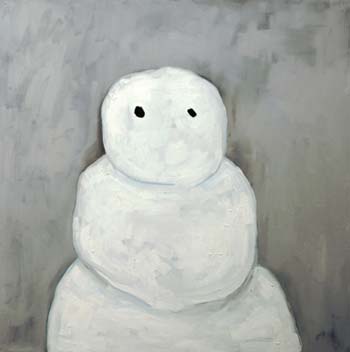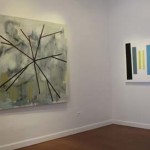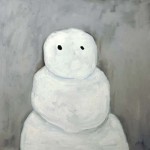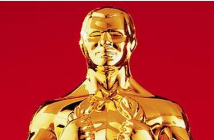A mouth-less snowman seems to cry out from a turbulent ground, imploring us with unseen lips, begging for some kind of crutch upon which it could utter the words of an unknown will. Beside the snowman hangs another unsettled ground, this time with a black fracturing snowflake-esque stick figure almost stamped into the canvas. The shape suggests that some force smacked the center of the canvas and its strength has radiated outward, like a crack gone awry on a windshield. It proposes that damaging paintings in such a fashion is possible and that the result would be a Lichtenstein-ian index of the collision. Across from the snowman sits a composition of six colored rectangles that seem like phases of development beginning at the paintings center. This illusion is abruptly ruined, or at the least tarnished, by two blue drips near the bottom of the canvas, calling us out of the painted reality.
In the quaint but open main room we are confronted again with three paintings that seek to draw us in and push us out with equal measure. In the largest piece, a giant black “X” cuts across a pristine white canvas negating its surface while emphasizing the precision with which the canvas was painted and primed. Another image implies a giant ball of yarn, which can only wrap us in the obvious-ness of it’s painted nature. A stoic looking Gargoyle dominates the final picture. Holding itself in the fetal position, as if it were a freshly scolded child, just emerging from is sadness with a colder, hardened heart. It stares out at us almost defiantly resolute, while we stare back and wonder if it was the painter or model who decided that the image should have five toes on one foot and only four on the other.
Ultimately, David Coyle and 40000 present us with a problem. Can a painting be both subject and object? Should we reflect upon the picture as being meaningful, even as we examine its nature, as painting, as being possibly more meaningful? Or do we look to the show itself as a collection to be the gesture from which we derive meaning? In Chicago, Coyle is not alone in this subject/object approach to painting. It seems in some ways to be the trajectory that painting has taken in the Windy City, one that began with artists like Gaylen Gerber and the gesture of creating artwork that is itself a structure for the support of other artworks. The next generation of Chicago painters, like Joe Baldwin and the duo of Michael Davis and Michael Langlios, are more engaged with each painting becoming its own new challenge and site of meaning that rest on the structure of painting, rather then image making. They seem almost to mock the forty years it took Gerhart Richter to paint his way though every conceivable kind of painting. These painters take on painting as a type of romantic problem in itself. They take on the problem of painting as a structure to support meaning and shift seamlessly through many painted vernaculars. Coyle’s work distinguishes itself here as well. He moves through and past this shifting vernacular and reflects a sensibility that is more melancholic while still being romantically enamored with the media. Each painting seems to recognize, yet remain invested in, the futility of themselves. Seeking again and again to reassert their painted nature and to confront us with an overwhelming awareness of the fact that we stand outside looking in. These are pictures that will never, and can never, swallow us in their reality.
Coyle is a painter who undoubtablely belongs beside the best and most interesting painters that call Chicago home. Yet his most engaging gesture, a video in the gallery’s project space titled "It's not you, it's me” reflects a comment about both the self and Coyle’s position as a painter. The video repeatedly shows the artist dressed in a plethora of costumes while a white noise distortion soundtrack washes over us. The images again and again re-assessing and re-asserting the multiplicity of individual possibilities of self in what appears to be a carnival -esque break up parade. While supporting this read, it also somehow contains the same affected romanticism of the paintings in the main space and seems to imply that our romances are futile and we will suffer the thousand scares of jerks hiding behind masks of all shapes and sizes telling us lies like “it’s not you it’s me” and somehow it does not stop the pain, but we retain the strange knowledge that we will still laugh about it later.
Links:
40000 in Chicago
"Blood On Your Saddle" is on until May 6th 2006 at 40000.
All images are courtesy of the artist and 40000.







